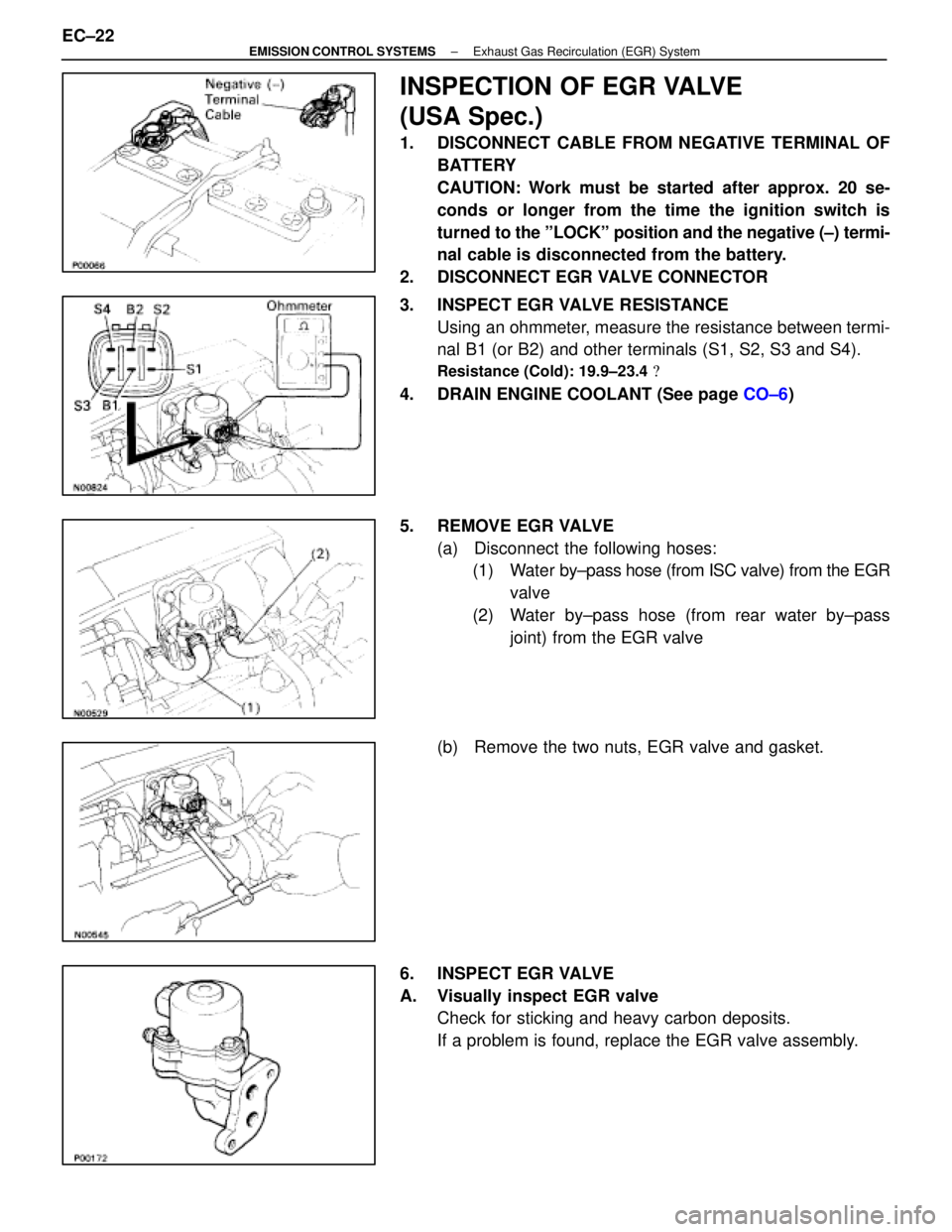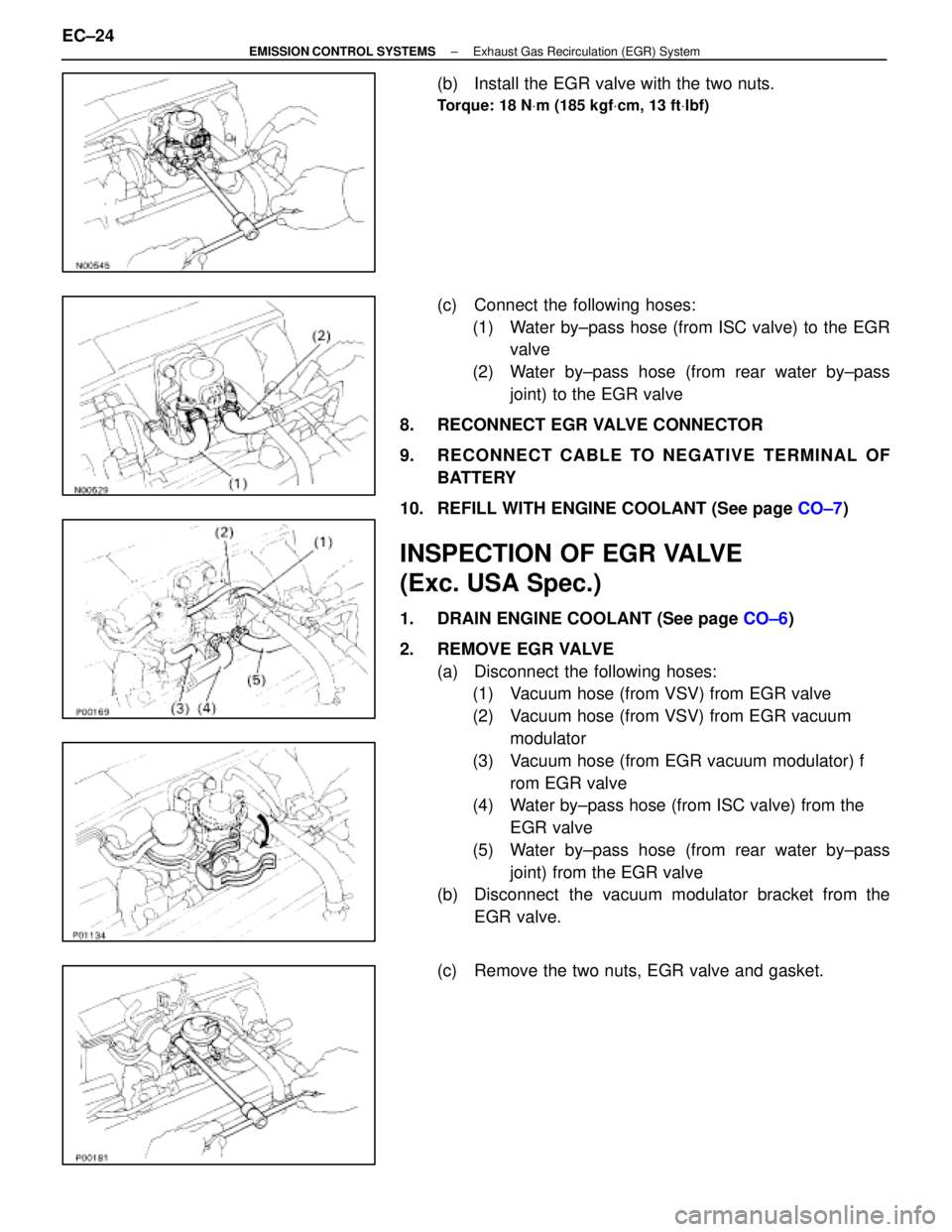Page 1349 of 4087

EXHAUST GAS RECIRCULATION (EGR) SYSTEM
DESCRIPTION
To reduce NOx emission, part of the exhaust gases are recirculated through\
the EGR valve to the intake man-
ifold to lower the maximum combustion temperature.
OPERATION
To reduce NOx emission, part of the exhaust gases are recirculated through\
the EGR valve to the intake manifold to lower the
maximum combustion temperature.
Coolant
Temp.VSVThrottle Valve OpeningPressure in the EGR Valve Pressure ChamberEGR VacuumModulatorEGR
ValveExhaust Gas
Below 45 �COPENCLOSEDNot recircu-
(113 �F)OPEN±±±CLOSEDlated
Positioned be-
low EGR port±±CLOSEDNot recircula- ted
Above 50 5C
(122 5F)CLOSEDPositioned be-
tween EGRport
(1)
LOW* Pressure constantly
alternating between
OPENS passage to atmosphereCLOSEDNot recircula- ted
tween EGR port
and R port(2)
HIGHalternating between
low and highOPENS passage
to atmosphereOPENRecirculated
Above 50 5C
(122 5F)CLOSEDPositioned
above R port(3)
HIGH**CLOSES passage to atmosphereOPENRecirculated(increase)
* Pressure increases Modulator closes EGR valve opens Pressure drops EGR Valve closes Modulator opens
** When the throttle valve is positioned above the R port, the EGR vacuum m\
odulator will close the atmosphere passage and
open the EGR valve to increase the EGR gas, even if the exhaust pressure\
is insufficiently low.
±
EMISSION CONTROL SYSTEMS Exhaust Gas Recirculation (EGR) SystemEC±11
WhereEverybodyKnowsYourName
Page 1351 of 4087
(e) Check whether the engine rpm increases 100±300 rpmunder the following conditions:
Coolant temp.
Below 45 5C (113 5F) . . . NO increase
Above 50 5C (122 5F) . . . Increases
INSPECTION OF VSV
1. REMOVE VSV
(a) Disconnect the VSV connector.
(b) Disconnect the two vacuum hoses from VSV.
(c) Remove the bolt and VSV from the intake manifold.
2. INSPECT VSV (a) Inspect VSV for open circuit.Using an ohmmeter, check that there is continuity be-
tween the terminals.
Resistance (Cold): 33±39 �
If there is no continuity, replace the VSV.
(b) Inspect VSV for ground.
Using an ohmmeter, check that there is no continuity be-
tween each terminal and the body.
If there is continuity, replace the VSV.
(c) Inspect VSV operation: 1) Check that the air flows from ports E to G
±
EMISSION CONTROL SYSTEMS Exhaust Gas Recirculation (EGR) SystemEC±13
WhereEverybodyKnowsYourName
Page 1355 of 4087
EXHAUST GAS RECIRCULATION (EGR) SYSTEM
DESCRIPTION
To reduce NOx emission, part of the exhaust gases are recirculated through\
the EGR valve to the intake
manifold to lower the maximum combustion temperature.
OPERATION
Coolant Temp.ConditionEGR ValveExhaust Gas
Below 53 5C (127 5F)±CLOSEDNot recirculated
Above 55 5C (131 5F)(a)Idling, Deceleration, Neutral,
Low air volume, High Engine speedCLOSEDNot recirculatedAbove 55 C (131 F)
Except (a)OPEN*Recirculated
* The ECU calculates the appropriate number of steps according to the in\
take air volume and the engine speed, then
drives the stepping motor to maintain the EGR volume at a level appropri\
ate to the driving conditions.
±
EMISSION CONTROL SYSTEMS Exhaust Gas Recirculation (EGR) SystemEC±15
WhereEverybodyKnowsYourName
Page 1357 of 4087
INSPECTION OF EGR SYSTEM (USA
Spec.)
INSPECT SYSTEM OPERATION
(a) Using SST, connect terminals TE1 and E1 of the check(ºDIAGNOSISº) connector.
SST 09843±18020
(b) Keep the engine at 3,500 rpm.
(c) Set the transmission shift lever to the ºNº position.
(d) Remove the SST from the check connector.
SST 09843±18020
(e) Check whether the engine rpm increases 100±300 rpm under the following conditions.
Coolant temp.
Below 53 5C (127 5F) No increase
Above 55 5C (131 5F) Increases
±
EMISSION CONTROL SYSTEMS Exhaust Gas Recirculation (EGR) SystemEC±17
WhereEverybodyKnowsYourName
Page 1358 of 4087
INSPECTION OF EGR SYSTEM
(Exc. USA Spec.)
1. CHECK AND CLEAN FILTERS IN EGR VACUUMMODULATOR
(a) Remove the cap and filter.
(b) Check the filter for contamination or damage.
(c) Using compressed air, clean the filters.
(d) Reinstall the filter and cap.
HINT: Install the filter with the coarser surface facing the at-
mospheric side (outward).
2. INSPECT SYSTEM OPERATION (a) Using SST, connect terminals TE1 and E1 of the check
(ºDIAGNOSISº) connector.
SST 09843±18020
(b) Keep the engine at 3,500 rpm.
(c) Set the transmission shift lever to the ºNº position.
(d) Remove the SST from the check connector.
SST 09843±18020
(e) Check whether the engine rpm increases 100±300 rpm under the following conditions:
Coolant temp.
Below 53 5C (127 5F) No increase
Above 55 5C (131 5F) Increases
EC±18
±
EMISSION CONTROL SYSTEMS Exhaust Gas Recirculation (EGR) System
WhereEverybodyKnowsYourName
Page 1362 of 4087

INSPECTION OF EGR VALVE
(USA Spec.)
1. DISCONNECT CABLE FROM NEGATIVE TERMINAL OFBATTERY
CAUTION: Work must be started after approx. 20 se-
conds or longer from the time the ignition switch is
turned to the ºLOCKº position and the negative (±) termi-
nal cable is disconnected from the battery.
2. DISCONNECT EGR VALVE CONNECTOR
3. INSPECT EGR VALVE RESISTANCE Using an ohmmeter, measure the resistance between termi-
nal B1 (or B2) and other terminals (S1, S2, S3 and S4).
Resistance (Cold): 19.9±23.4 �
4. DRAIN ENGINE COOLANT (See page CO±6)
5. REMOVE EGR VALVE (a) Disconnect the following hoses:(1) Water by±pass hose (from ISC valve) from the EGR
valve
(2) Water by±pass hose (from rear water by±pass joint) from the EGR valve
(b) Remove the two nuts, EGR valve and gasket.
6. INSPECT EGR VALVE
A. Visually inspect EGR valve Check for sticking and heavy carbon deposits.
If a problem is found, replace the EGR valve assembly.
EC±22
±
EMISSION CONTROL SYSTEMS Exhaust Gas Recirculation (EGR) System
WhereEverybodyKnowsYourName
Page 1364 of 4087

(b) Install the EGR valve with the two nuts.
Torque: 18 NVm (185 kgf Vcm, 13 ft Vlbf)
(c) Connect the following hoses:
(1) Water by±pass hose (from ISC valve) to the EGR valve
(2) Water by±pass hose (from rear water by±pass joint) to the EGR valve
8. RECONNECT EGR VALVE CONNECTOR
9. RECONNECT CABLE TO NEGATIVE TERMINAL OF BATTERY
10. REFILL WITH ENGINE COOLANT (See page CO±7)
INSPECTION OF EGR VALVE
(Exc. USA Spec.)
1. DRAIN ENGINE COOLANT (See page CO±6)
2. REMOVE EGR VALVE (a) Disconnect the following hoses:(1) Vacuum hose (from VSV) from EGR valve
(2) Vacuum hose (from VSV) from EGR vacuum
modulator
(3) Vacuum hose (from EGR vacuum modulator) f rom EGR valve
(4) Water by±pass hose (from ISC valve) from the
EGR valve
(5) Water by±pass hose (from rear water by±pass joint) from the EGR valve
(b) Disconnect the vacuum modulator bracket from the
EGR valve.
(c) Remove the two nuts, EGR valve and gasket.
EC±24
±
EMISSION CONTROL SYSTEMS Exhaust Gas Recirculation (EGR) System
WhereEverybodyKnowsYourName
Page 1365 of 4087
3. INSPECT EGR VALVECheck for sticking and heavy carbon deposits.
If a problem is found, replace the EGR valve assembly.
4. REINSTALL EGR VALVE (a) Place a new gasket on the EGR valve adaptor.
NOTICE:
w Do not touch the adaptor and EGR valve surfaces of the
gasket with your hand.
w Align the port holes of the gasket and adaptor.
Be careful of the installation direction.
(b) Install the EGR valve with the two nuts.
Torque: 18 N Vm (185 kgf Vcm, 13 ft Vlbf)
(c) Install the vacuum modulator bracket to the EGR valve.
(d) Connect the following hoses:
(1) Vacuum hose (from VSV) to EGR valve
(2) Vacuum hose (from VSV) to EGR vacuum modula- tor
(3) Vacuum hose (from EGR vacuum modulator) to EGR valve
(4) Water by±pass hose (from ISC valve) to the EGR
valve
(5) Water by±pass hose (from rear water by±pass joint) to the EGR valve
5. REFILL WITH ENGINE COOLANT (See page CO±7)
±
EMISSION CONTROL SYSTEMS Exhaust Gas Recirculation (EGR) SystemEC±25
WhereEverybodyKnowsYourName